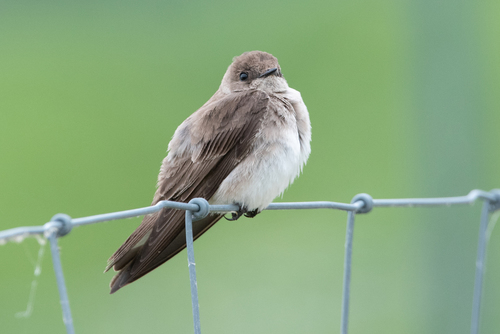
Northern Rough-winged Swallow
The Northern Rough-winged Swallow (*Stelgidopteryx serripennis*) is a small, migratory songbird found throughout North and Central America. It is known for the tiny serrations on the outer edge of its primary feathers, a unique characteristic that gives the bird its name, although the function of these barbs is not fully understood. This swallow plays a crucial role in insect control, consuming large quantities of flying insects. It is not particularly known for vibrant colors or elaborate songs, being a rather drab, brownish-gray bird, but its agile flight and widespread distribution make it a familiar sight near waterways and open areas.
12-15 cm
Length
27-30 cm
Wingspan
Least Concern
Conservation Status
Distribution
Breeds across North America, from southern Alaska and Canada south through the United States and Mexico into Central America. Winters in southern Mexico and Central America, with some populations along the Gulf Coast of the United States. It has a wide altitudinal range, from sea level to around 2,500 meters.
Lifespan
Average lifespan in the wild is 2-4 years, with a maximum recorded lifespan of 8 years.
Northern Rough-winged Swallow's Habitat
Habitat Types
Open areas near water, Riverbanks, Cliffs, Road cuts, Burrows
Climate Zones
Temperate, Subtropical, Tropical
Adaptations
Often nests in burrows, either self-excavated in earthen banks or using pre-existing cavities made by other animals like kingfishers or bank swallows. This provides protection from predators and the elements.
Variations
Several subspecies are recognized, differing slightly in plumage and size. For example, *S. s. serripennis* is the widespread North American subspecies, while others are found in Mexico and Central America.
Appearance
Breeding Plumage
Little to no difference between breeding and non-breeding plumage.
Seasonal Feather Changes
No significant seasonal variations.
Sex Based Plumage Differences
Males and females have very similar plumage; both are brownish-gray above and paler below, with a slightly darker throat.
Notable Features
Small serrations on the outer primary feathers (more prominent in males), Brownish-gray upperparts, Pale underparts, Slightly forked tail
Diet and Feeding
Primary Foods
Flying insects, Flies, Beetles, Wasps, Ants, Moths
Foraging Behavior
Forages in flight, capturing insects on the wing. Often seen flying low over water or open fields, exhibiting agile and erratic flight patterns.
Specializations
Its relatively broad wings and agile flight allow it to maneuver effectively while pursuing insects.
Seasonal Diet Variations
Diet consists almost entirely of insects throughout the year. During the breeding season, they may focus on larger, more nutritious insects to feed their young.
Behavior
Social Structure
Generally less social than other swallow species, often seen singly or in small groups. However, they can form larger flocks during migration.
Communication
Chattering calls, Twittering sounds, Visual displays during courtship
Migration
Migrates from North America to Central America and southern parts of North America for the winter. Migration is typically nocturnal.
Territorial or Group Behaviors
Territorial during the breeding season, defending the area around their nest burrow. Outside of the breeding season, they are less territorial.
Conservation
Threats
Habitat loss, Pesticide use, Collisions with vehicles, Climate change (potential impacts on insect populations)
Protection Programs
General bird conservation efforts (e.g., habitat preservation), Monitoring programs
Local National Laws
Protected under the Migratory Bird Treaty Act in the United States, Canada, and Mexico.
Population Trend
Stable
Population Estimates
Global population estimated to be around 14,000,000.
Interesting Facts
The tiny barbs on their outer primary feathers are unique among North American swallows.
The purpose of these barbs is not fully understood, but they may play a role in sound production or tactile sensing.
They are often seen skimming the surface of water bodies.
They do this to drink or bathe while in flight.
Unlike many other swallows, they do not typically nest in large colonies.
This solitary nesting behavior may be related to the availability of suitable burrow sites.
Faqs about Northern Rough-winged Swallow
What do Northern Rough-winged Swallows eat?
They eat flying insects, including flies, beetles, wasps, ants, and moths.
Where do Northern Rough-winged Swallows nest?
They nest in burrows in earthen banks, or crevices in cliffs, bridges, or culverts.
Are Northern Rough-winged Swallows endangered?
No, they are classified as Least Concern by the IUCN.
How can I attract Northern Rough-winged Swallows?
Maintain open grassy areas near water and avoid using pesticides. Providing suitable nesting sites, like undisturbed earthen banks, can also help.
Copyright @ Nature Style Limited. All Rights Reserved.
 English
English